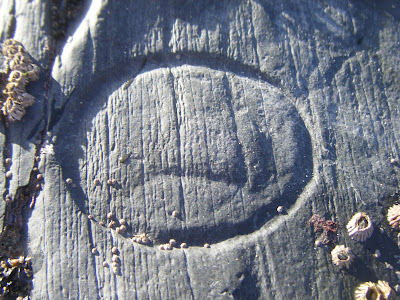 |
| Common Limpet, Patella vulgata |
Probably the most familiar intertidal organism on western European coastlines is the Common Limpet, Patella vulgata. Its conical shell can often be seen in enormous numbers on rocky shore of all degrees of wave action, and numbers are maintained by the relatively long life of certain individuals. Where conditions promote slow growth, some individuals can live up to 17 years of age (1). For a sedate looking animal, often encountered encrusted with algae and barnacles, they are voracious feeders. Although they have been reported to consume a wide variety of micororganisms (2), algae of the intertidal zone is the food of choice. And what a choice; P. vulagata feeds a plethora of different species, including Fucus spp., Ulva spp. and red encrusting algae (1). This is all facilitated by the iron and silica hardened teeth on the radula, which rasp the algae with incredible efficiency. In situations where P. vulagata have been artificially removed form shorelines, Ulva spp. have quickly covered the rocks.
 |
| Common Limpet Home Scar |
A rocky shore is not for the faint of heart, with waves action dislodging anything not firmly attaced to its surface. Organisms need to be firmly attached to the rock, and P. vulgata is truly a master at this. Depending on where the animal is to be found on the rock face, the shell height will vary. Those at high shore levels have tall shells with a small shell length, while individuals at a low shore levels have shorter but longer shells, which keeps them closer to the rock (1). P. vulgata attaches to their substrate by using a combination of suction and glue like adhesion (3). The specific mode of attachment is dependant on their location at the time. At high tide, when P. vulgata is at its most active feeding, suction is employed. This involves decreasing the pressure under the foot of the animal which forms a tight seal with the substrate. At low tide, when foraging does not occur due to the increase risk of predation, P. vulgata employs a glue-like secretion from its foot which creates a seal that is stronger than that created by suction, however it is more permanent and does not allow movement for foraging. At rest, P. vulgata also employs a home scar, a depression created in the substrate by chemical action and abrasion by the shell of the animal. This is returned to after each foraging excursion as it increases the adhesion power significantly (4).
References:
References:
- Fish and Fish, 2011. A Student's Guide to the Seashore pp. 205-206
- Jenkins and Hartnol, 2001. Journal of Experimental Marine Biology and Ecology 30 pp. 123-139
- Smith, 1992. Journal of Experimental Marine Biology and Ecology 1600 pp. 205-220
- Smith, 1991. Journal of Experimental Biology 161 pp. 151-169
No comments:
Post a Comment